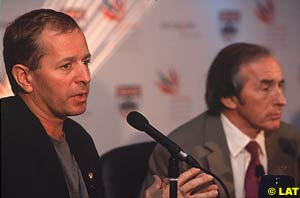
Contributing Writer
For the past 51 years, Great Britain has played a part in every Formula One World Championship season. Last week however, the country came under serious threat of removal from the 2002 calendar. Paul Ryder looks at why Great Britain came close to losing the jewel of its motor racing crown, and the growing frustration of its Formula One fans
Since the birth of Formula One in 1950, Silverstone has been regarded as the home of British Motor Racing. It was the location for the first ever official Formula One race on May 13th 1950, and has hosted a further 35 races, sharing the remaining years with the Brands Hatch and Aintree circuits.
However, recently there has been an increasingly frustrated view of Silverstone from both the Formula One governing body, the FIA, and motor racing fans alike. Traffic congestion issues, combined with lack of work on the circuit and facilities resulted in the FIA threatening to drop the race from the 2002 Formula One calendar, signalling the end of their patience with the venue.
So what has been the cause of Silverstone's problems?
Due to its fairly remote countryside location, which is common for most circuits in the United Kingdom, traffic congestion has always been a problem for the circuit. Small twisting roads, combined with little towns and villages local to the circuit mean that long queues form as visitors slowly make their way to the circuit, which is nestled deep in the heart of Northamptonshire. This was an accepted issue that travelling Grand Prix fans just had to put up with. The Grand Prix, for 50 years scheduled for the middle of July, would often by met with a hot and sunny summer weekend. Last year however would turn out to be an entirely different matter.
April arrived, and so did the rain. The weeks leading up to the British Grand Prix saw heavy rainfalls. By the time the race weekend arrived, the local fields, key to car parking at the circuit, were water logged and muddy. As the stream of spectators arrived in cars on Thursday, the problems began. Spectators found themselves bogged in waterlogged fields that the circuit has always used as car parks. Fans struggled to walk, let alone drive to the circuit as paths became flooded with mud and water. The problems were serious, and led to the organisers of the Grand Prix issuing a plea to the travelling fans, requesting they stay away on qualifying Saturday.
"Basically we are saying that if you bought Saturday tickets and you are not here already and were coming by car, do not come," said Peter Morris, general manager of corporate communications at the circuit.
Sunday faired a little better with good conditions for the race. However, most of the damage to the reputation of Silverstone had already been done. After a public apology to the fans, the British Racing Drivers Club, organisers of the race, were called to appear in front of the FIA to discuss the problems that occurred.
A year later, British Grand Prix organisers announced a $60 million plan to "revamp" Silverstone. The changes included alterations to the circuit layout, an entire new pit and paddock complex, along with major improvements to parking around the circuit. Also in the pipeline would be a road bypass which will hopefully ease congestion greatly. The plan was backed by key names such as British Racing Drivers' Club president Jackie Stewart and British Racing Drivers' Club chairman, commentator and former F1 driver Martin Brundle, and given an investment of funds by Bernie Ecclestone.
As a result, in October the FIA elected to make the British Grand Prix a provisional inclusion on the 2002 Formula One calendar.
The FIA then scheduled that the British Grand Prix would be discussed at the FIA summit, held in Monte Carlo on December 14th. This caused strong rumours to circulate that the race could be dropped in favour of an unofficial event due to the continued problems and broken promises.
Had the FIA lost patience with Silverstone, Octagon, and the apparent lack of work on the circuit and its traffic problems?
Stewart was understandably frustrated.
"Britain is the capital of motorsport. For Britain not to have a Grand Prix
would be ridiculous," he said. "Cancelling this Grand Prix, if it were to happen and I really don't thinkit will happen ... would obviously dissolve any of the negotiations we're having with the government and would seriously affect motorsport in this
country."
"The promoter is going to put up a $5m bond which will be forfeited if the
roads are not completed," said FIA President Max Mosley. "The pressure is on. I think if it can be done they will do it and it's quite clear if they don't succeed, that will be that."
"There has been constant pressure on the organisers but it produced no
results. The only real change at Silverstone over the last 10 years has been the
building of a palatial clubhouse for the members of the British Racing
Drivers' Club, which is just a few hundred people."
Octagon expressed how delighted they were at the decision to allow the British Grand Prix to remain on the calendar, and underlined their commitment to demonstrate their confidence. The immediate future of the British Grand Prix, at least for another year, is safe.
But what about the fans?
As part of their efforts to reduce traffic problems during the Grand Prix weekend, Octagon also announced changes to the way they would handle spectators for the 2002 Grand Prix. The total amount of ticket sales has been reduced by 30,000. More importantly for the fans, all prices were raised, and ticket options reduced.
For a single adult to enter the circuit and stand to watch qualifying and the race, also by car, the price is a staggering 244 pounds.
Under the new scheme, all fans are forced to buy '3 day tickets' which include access for Friday, Saturday and Sunday, but also include drastically high prices. There is no option to purchase tickets for one day alone, which has been a standard feature at British motor racing events.
But what if you want to sit down on prefabricated seating structures? Heading back to our family of four, again attending Saturday and Sunday by car but seated within the circuit, would have to purchase tickets to the value of an amazing 943 pounds. For that price, the family could invest in a top of the range widescreen television set, and watch the race from the comfort of their own living room. A single adult would be faced with a cost of 349 pounds for the same pleasure.
So how do these prices compare with other Grands Prix around the world?
For a single adult to gain general admission on Saturday and Sunday, standing, the prices are as follows:
Silverstone's prices are clearly well above prices charged at other circuits around the world.
Octagon clearly have many promises to keep, and even more fans to keep
happy. Their success will decide the future of Formula One races and motorsport
in general in the United Kingdom.
 For the seven Formula One teams that are based in Great Britain, the Silverstone race is regarded as their homecoming. Held at the height of British summer time, it has held a relatively unclouded past. Over the years the circuit has seen many exciting races and incidents, surviving a mass track invasion in 1992 when 'Mansell Mania' took hold.
For the seven Formula One teams that are based in Great Britain, the Silverstone race is regarded as their homecoming. Held at the height of British summer time, it has held a relatively unclouded past. Over the years the circuit has seen many exciting races and incidents, surviving a mass track invasion in 1992 when 'Mansell Mania' took hold.
 In October 1999, the FIA announced the official 2000 Formula One calendar, featuring 17 races. In the calendar the British Grand Prix was surprisingly scheduled to run in April, as opposed to its usual July fixture. This was unheard of in the history of the British Grand Prix. Never since 1950 had the Grand Prix been staged outside of July. April would set the race in the middle of the British spring. The reason given for the change of month was a mixture of concerns over fixture conflicts between both the Wimbledon tennis finals which occur in July, and the World Cup in France that coincided with the French Grand Prix.
In October 1999, the FIA announced the official 2000 Formula One calendar, featuring 17 races. In the calendar the British Grand Prix was surprisingly scheduled to run in April, as opposed to its usual July fixture. This was unheard of in the history of the British Grand Prix. Never since 1950 had the Grand Prix been staged outside of July. April would set the race in the middle of the British spring. The reason given for the change of month was a mixture of concerns over fixture conflicts between both the Wimbledon tennis finals which occur in July, and the World Cup in France that coincided with the French Grand Prix.
 Silverstone effectively banned cars from its car parks on the Saturday in an attempt to use the day to put in place emergency clean up measures to ensure smooth running on Sunday. Thousands of fans were left angry and upset that what had been dubbed as the perfect weekend out for the family had been spoiled.
Silverstone effectively banned cars from its car parks on the Saturday in an attempt to use the day to put in place emergency clean up measures to ensure smooth running on Sunday. Thousands of fans were left angry and upset that what had been dubbed as the perfect weekend out for the family had been spoiled.
 A month later, the 2001 British Grand Prix was hailed as a success, with Octagon surprisingly boasting record attendance numbers for the weekend. Back to its normal July schedule, the race weekend was rain free. It was not without traffic problems once again, albeit dry ones.
A month later, the 2001 British Grand Prix was hailed as a success, with Octagon surprisingly boasting record attendance numbers for the weekend. Back to its normal July schedule, the race weekend was rain free. It was not without traffic problems once again, albeit dry ones.
 Octagon Motorsports immediately acted to calm the situation, publishing details of a revised traffic plan to be completed in time for the 2002 British Grand Prix, costing 10.6 million pounds. Octagon further backed up their plans by offering the FIA a five million dollar bond which would be forfeited if the roads are not ready in time. It was also made clear that should Octagon fail to meet their promises, then the race in 2003 would be on very shaky ground.
Octagon Motorsports immediately acted to calm the situation, publishing details of a revised traffic plan to be completed in time for the 2002 British Grand Prix, costing 10.6 million pounds. Octagon further backed up their plans by offering the FIA a five million dollar bond which would be forfeited if the roads are not ready in time. It was also made clear that should Octagon fail to meet their promises, then the race in 2003 would be on very shaky ground.
 For a family of four (2 adults, 2 children) to attend qualifying and the race by car, purchasing general admission tickets to stand and watch the race from within the circuit, the total cost is 543 pounds.
For a family of four (2 adults, 2 children) to attend qualifying and the race by car, purchasing general admission tickets to stand and watch the race from within the circuit, the total cost is 543 pounds.
Venue Cost
Silverstone, Britain 244 pounds (393 euros)
Spa-Francorchamps, Belgium 180 euros
Magny-Cours, France 93 euros
Melbourne, Australia 155 dollars (88 euros)
Please Contact Us for permission to republish this or any other material from Atlas F1.
|
Volume 7, Issue 51
Articles
Coulthard's Last Chance
Far from the Muddy Crowd
Columns
Elsewhere in Racing
Bookworm Critique
The Weekly Grapevine
> Homepage |